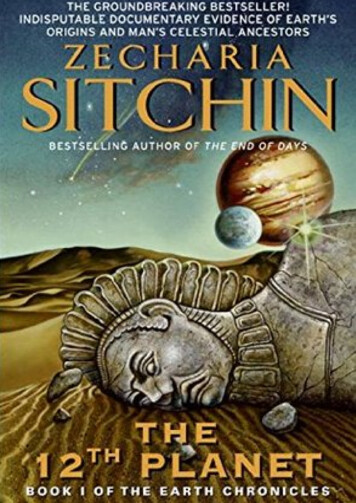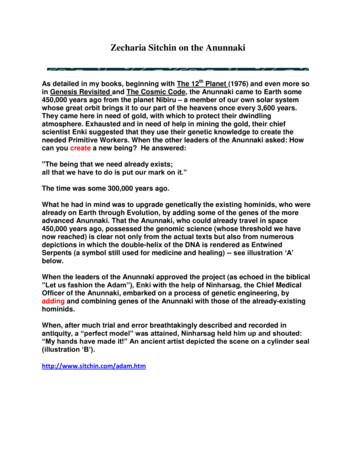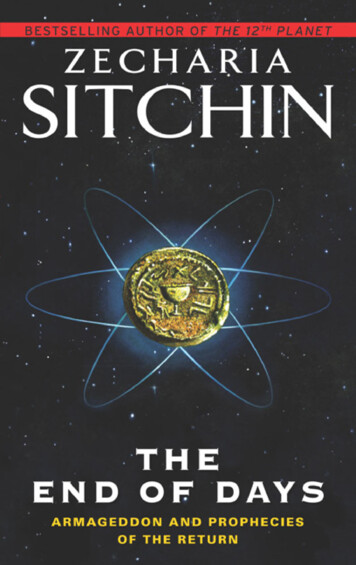
Transcription
The 12th Planet - Sitchin Zecharia 1983GENESISTHE PRIME SOURCE for the biblical verses quoted in The Twelfth Planet is the Old Testament in its originalHebrew text. It must be borne in mind that all the translations consulted of which the principal ones are listed at theend of the book - are just that: translations or interpretations. In the final analysis, what counts is what theoriginal Hebrew says.In the final version quoted in The Twelfth Planet, I have compared the available translations against each other andagainst the Hebrew source and the parallel Sumerian and Akkadian texts/tales, to come up with what Ibelieve is the most accurate rendering.The rendering of Sumerian, Assyrian, Babylonian, and Hittite texts has engaged a legion of scholars for more than acentury. Decipherment of script and language was followed by transcribing, transliterating, and finally,translating. In many instances, it was possible to choose between differing translations or interpretations only byverifying the much earlier transcriptions and transliterations. In other instances, a late insight by a contemporaryscholar could throw new light on an early translation.The list of sources for Near Eastern texts, given at the end of this book, thus ranges from the oldest to the newest,and is followed by the scholarly publications in which valuable contributions to the understanding of the textswere found.THE OLD TESTAMENT has filled my life from childhood. When the seed for this book was planted, nearly fiftyyears ago, I was totally unaware of the then raging Evolution versus Bible debates. But as a young schoolboystudying Genesis in its original Hebrew, I created a confrontation of my own. We were reading one day in ChapterVI that when God resolved to destroy Mankind by the Great Flood, "the sons of the deities", who married thedaughters of men, were upon the Earth. The Hebrew original named them Nefilim; the teacher explained it meant"giants"; but I objected: didn't it mean literally "Those Who Were Cast Down", who had descended to Earth? I wasreprimanded and told to accept the traditional interpretation.In the ensuing years, as I have learned the languages and history and archaeology of the ancient Near East, theNefilim became an obsession. Archaeological finds and the deciphering of Sumerian, Babylonian, Assyrian,Hittite, Canaanite and other ancient texts and epic tales increasingly confirmed the accuracy of the biblicalreferences to the kingdoms, cities, rulers, places, temples, trade routes, artifacts, tools and customs of antiquity. Is itnot now time, therefore, to accept the word of these same ancient records regarding the Nefilim as visitors to Earthfrom the heavens?The Old Testament repeatedly asserted: "The throne of Yahweh is in heaven" - "from heaven did the Lord beholdthe Earth". The New Testament spoke of "Our Father, which art in Heaven". But the credibility of the Bible wasshaken by the advent and general acceptance of Evolution. If Man evolved, then surely he could not have beencreated all at once by a Deity who, premeditating, had suggested "Let us make Adam in our image and after ourlikeness". All the ancient peoples believed in gods who had descended to Earth from the heavens and who could atwill soar heavenwards. But these tales were never given credibility, having been branded by scholars from the verybeginning as myths.The writings of the ancient Near East, which include a profusion of astronomical texts, clearly speak of a planetfrom which these astronauts or "gods" had come. However, when scholars, fifty and one hundred years ago,deciphered and translated the ancient lists of celestial bodies, our astronomers were not yet aware of Pluto (whichwas only located in 1930). How then could they be expected to accept the evidence of yet one more member of oursolar system? But now that we too, like the ancients, are aware of the planets beyond Saturn, why not accept thatancient evidence for the existence of the Twelfth Planet?As we ourselves venture into space, a fresh look and an acceptance of the ancient scriptures is more than timely.Now that astronauts have landed on the Moon, and unmanned spacecraft explore other planets, it is no longerimpossible to believe that a civilization on another planet more advanced than ours was capable of landing itsastronauts on the planet Earth some time in the past.1
Indeed, a number of popular writers have speculated that ancient artifacts such as the pyramids and giant stonesculptures must have been fashioned by advanced visitors from another planet - for surely primitive man couldnot have possessed by himself the required technology? How was it, for another example, that the civilization ofSumer seemed to flower so suddenly nearly 6,000 years ago without a precursor? But since these writers usuallyfail to show when, how and, above all, from where such ancient astronauts did come - their intriguing questionsremain unanswered speculations.It has taken thirty years of research, of going back to the ancient sources, of accepting them literally, to re- createin my own mind a continuous and plausible scenario of prehistoric events. The Twelfth Planet, therefore, seeksto provide the reader with a narrative giving answers to the specific questions of When, How, Why andWherefrom.The evidence I adduce consists primarily of the ancient texts and pictures themselves.In The Twelfth Planet I have sought to decipher a sophisticated cosmogony which explains, perhaps as well asmodern scientific theories, how the solar system could have been formed, an invading planet caught into solarorbit, and Earth and other parts of the solar system brought into being.The evidence I offer includes celestial maps dealing with space flight to Earth from that Planet, the Twelfth.Then, in sequence, follow the dramatic establishment of the first settlements on Earth by the Nefilim: theirleaders were named; their relationships, loves, jealousies, achievements and struggles described; the nature oftheir "immortality" explained.Above all, The Twelfth Planet aims to trace the momentous events that led to the creation of Man, and theadvanced methods by which this was accomplished. It then suggests the tangled relationship between Man and hislords, and throws fresh light on the meaning of the events in the Garden of Eden, of the Tower of Babel, of thegreat Flood. Finally, Man - endowed by his makers biologically and materially- - ends up crowding his gods offthe Earth.This book suggests that we are not alone in our solar system. Yet it may enhance rather than diminish the faithin a universal Almighty. For, if the Nefilim created Man on Earth, they may have only been fulfilling a vasterMaster Plan.Z. SITCHIN New York, February 1977THE ENDLESS BEGINNINGOF THE EVIDENCE that we have amassed to support our conclusions, exhibit number one is Man himself. Inmany ways, modern man - Homo sapiens - is a stranger to Earth.Ever since Charles Darwin shocked the scholars and theologians of his time with the evidence of evolution, lifeon Earth has been traced through Man and the primates, mammals, and vertebrates, and backward through everlower life forms to the point, billions of years ago, at which life is presumed to have begun.But having reached these beginnings and having begun to contemplate the probabilities of life elsewhere in oursolar system and beyond, the scholars have become uneasy about life on Earth: Somehow, it does not belong here.If it began through a series of spontaneous chemical reactions, why does life on Earth have but a single source, andnot a multitude of chance sources? And why does all living matter on Earth contain too little of the chemicalelements that abound on Earth, and too much of those that are rare on our planet?Was life, then, imported to Earth from elsewhere?Man's position in the evolutionary chain has compounded the puzzle. Finding a broken skull here, a jaw there,scholars at first believed that Man originated in Asia some 500,000 years ago. But as older fossils were found, itbecame evident that the mills of evolution grind much, much slower. Man's ancestor apes are now placed at astaggering 25,000,000 years ago. Discoveries in East Africa reveal a transition to manlike apes (hominids) some14,000,000 years ago. It was about 11,000,000 years later that the first ape-man worthy of the classification Homoappeared there.2
The first being considered to be truly manlike - "Advanced Australopithecus" - existed in the same parts of Africasome 2,000,000 years ago. It took yet another million years to produce Homo erectus. Finally, after another900,000 years, the first primitive Man appeared; he is named Neanderthal after the site where his remains werefirst found.In spite of the passage of more than 2,000,000 years between Advanced Australopithecus and Neanderthal, thetools of these two groups - sharp stones - were virtually alike; and the groups themselves (as they are believed tohave looked) were hardly distinguishable.Then, suddenly and inexplicably, some 35,000 years ago, a new race of Men - Homo sapiens ("thinking Man") appeared as if from nowhere, and swept Neanderthal Man from the face of Earth. These modern Men - namedCro-Magnon - looked so much like us that, if dressed like us in modern clothes, they would be lost in the crowdsof any European or American city. Because of the magnificent cave art which they created, they were at firstcalled "cavemen." In fact, they roamed Earth freely, for they knew how to build shelters and homes of stones andanimal skins wherever they went.For millions of years, Man' s tools had been simply stones of useful shapes. Cro-Magnon Man, however, madespecialized tools and weapons of wood and bones. He was no longer a "naked ape," for he used skins forclothing. His society was organized; he lived in clans with a patriarchal hegemony. His cave drawings bespeakartistry and depth of feeling; his drawings and sculptures evidence some form of "religion," apparent in theworship of a Mother Goddess, who was sometimes depicted with the sign of theMoon' s crescent. He buried his dead, and must therefore have had some philosophies regarding life, death, andperhaps even an afterlife.As mysterious and unexplained as the appearance of Cro-Magnon Man has been, the puzzle is still morecomplicated. For, as other remains of modern Man were discovered (at sites including Swanscombe, Steinheim,and Montmaria), it became apparent that Cro-Magnon Man stemmed from an even earlier Homo sapiens wholived in western Asia and North Africa some 2500000 years before Cro-Magnon Man.The appearance of modem Man a mere 700,000 years after Homo erectus and some 200,000, years beforeNeanderthal Man is absolutely implausible. It is also clear that Homo sapiens represents such an extreme departurefrom the slow evolutionary process that many of our features, such as the ability to speak, are totally unrelated tothe earlier primates.An outstanding authority on the subject, Professor Theodosius Dobzhansky (Mankind Evolving), was especiallypuzzled by the fact that this development took place during a period when Earth was going through an ice age, amost unpropitious time for evolutionary advance. Pointing out that Homo sapiens lacks completely some of thepeculiarities of the previously known types, and has some that never appeared before, he concluded: "Modern manhas many fossil collateral relatives but no progenitors; the derivation of Homo sapiens, then, becomes a puzzle."How, then, did the ancestors of modern Man appear some 300,000 years ago - instead of 2,000,000 or 3,000,000years in the future, following further evolutionary development? Were we imported to Earth from elsewhere, orwere we, as the Old Testament and other ancient sources claim, created by the gods?We now know where civilization began and how it developed, once it began. The unanswered question is: Why why did civilization come about at all? For, as most scholars now admit in frustration, by all data Man should stillbe without civilization. There is no obvious reason that we should be any more civilized than the primitive tribes ofthe Amazon jungles or the inaccessible parts of New Guinea, but, we are told, these tribesmen still live as if in theStone Age because they have been isolated. But isolated from what? If they have been living on the same Earth aswe, why have they not acquired the same knowledge of sciences and technologies on their own as we supposedlyhave?The real puzzle, however, is not the backwardness of the Bushmen, but our advancement; for it is now recognizedthat in the normal course of evolution Man should still be typified by the Bushmen and not by us. It took Mansome 2,000,000 years to advance in his "tool industries" from the use of stones as he found3
them to the realization that he could chip and shape stones to better suit his purposes. Why not another2,000,000 years to learn the use of other materials, and another 10,000,000 years to master mathematics andengineering and astronomy? Yet here we are, less than 50,000 years from Neanderthal Man, landing astronautson the Moon.The obvious question, then, is this: Did we and our Mediterranean ancestors really acquire this advancedcivilization on our own?Though Cro-Magnon Man did not build skyscrapers nor use metals, there is no doubt that his was a sudden andrevolutionary civilization. His mobility, ability to build shelters, his desire to clothe himself, his manufacturedtools, his art - all were a sudden high civilization breaking an endless beginning of Man' s culture that stretchedover millions of years and advanced at a painfully slow pace.Though our scholars cannot explain the appearance of Homo sapiens and the civilization of Cro-Magnon Man,there is by now no doubt regarding this civilization' s place of origin: the Near East.The uplands and mountainranges that extend in a semiarc from the Zagros Mountains in the east (where present-day Iran and Iraq border oneach other), through the Ararat and Taurus ranges in the north, then down, westward and southward, to the hilllands of Syria, Lebanon, and Israel, are replete with caves where the evidence of prehistoric but modern Man hasbeen preserved.One of these caves, Shanidar, is located in the northeastern part of the semiarc of civilization. Nowadays, fierceKurdish tribesmen seek shelter in the area' s caves for themselves and their flocks during the cold wintermonths. So it was, one wintry night 44,000 years ago, when a family of seven (one of whom was a baby) soughtshelter in the cave of Shanidar.Their remains - they were evidently crushed to death by a rockfall - were discovered in 1957 by a startled RalphSolecki, who went to the area in search of evidence of early Man (Professor Solecki has told me that nineskeletons were found, of which only four were crushed by rockfall.) What he found was more than he expected.As layer upon layer of debris was removed, it became apparent that the cave preserved a clear record of Man' shabitation in the area from about 100,000 to some 13,000 years ago.What this record showed was as surprising as the find itself. Man' s culture has shown not a progression but aregression. Starting from a certain standard, the following generations showed not more advanced but lessadvanced standards of civilized life. And from about 27,000 B.C. to 11,000 B.C., the regressing and dwindlingpopulation reached the point of an almost complete absence of habitation. For reasons that are assumed to havebeen climatic, Man was almost completely gone from the whole area for some 16,000 years.And then, circa 11,000 B.C., "thinking Man" reappeared with new vigor and on an inexplicably higher culturallevel.It was as if an unseen coach, watching the faltering human game, dispatched to the field a fresh and better- trainedteam to take over from the exhausted one. Throughout the many millions of years of his endless beginning, Manwas nature' s child; he subsisted by gathering the foods that grew wild, by hunting the wild animals, by catchingwild birds and fishes. But just as Man' s settlements were thinning out, just as he was abandoning his abodes,when his material and artistic achievements were disappearing - just then, suddenly, with no apparent reason andwithout any prior known period of gradual preparation - Man became a farmer.Summarizing the work of many eminent authorities on the subject, R. J. Braidwood and B. Howe (PrehistoricInvestigations in Iraqi Kurdistan) concluded that genetic studies confirm the archaeological finds and leave nodoubt that agriculture began exactly where Thinking Man had emerged earlier with his first crude civilization: inthe Near East. There is no doubt by now that agriculture spread all over the world from the Near Eastern arc ofmountains and highlands.4
Employing sophisticated methods of radiocarbon dating and plant genetics, many scholars from various fields ofscience concur in the conclusion that Man' s first farming venture was the cultivation of wheat and barley, probablythrough the domestication of a wild variety of emmer. Assuming that, somehow, Man did undergo a gradualprocess of teaching himself how to domesticate, grow, and farm a wild plant, the scholars remain baffled by theprofusion of other plants and cereals basic to human survival and advancement that kept coming out of the NearEast. These included, in rapid succession, millet, rye, and spelt, among the edible cereals; flax, which providedfibers and edible oil; and a variety of fruit-bearing shrubs and trees. In every instance, the plant was undoubtedlydomesticated in the Near East for millennia before it reached Europe. It was as though the Near East were somekind of genetic-botanical laboratory, guided by an unseen hand, producing every so often a newly domesticatedplant.The scholars who have studied the origins of the grapevine have concluded that its cultivation began in themountains around northern Mesopotamia and in Syria and Palestine. No wonder. The Old Testament tells us thatNoah "planted a vineyard" (and even got drunk on its wine) after his ark rested on Mount Ararat as the waters ofthe Deluge receded. The Bible, like the scholars, thus places the start of vine cultivation in the mountains ofnorthern Mesopotamia. Apples, pears, olives, figs, almonds, pistachios, walnuts - all originated in the Near Eastand spread from there to Europe and other parts of the world. Indeed, we cannot help recalling that the OldTestament preceded our scholars by several millennia in identifying the very same area as the world' s firstorchard: "And the Lord God planted an orchard in Eden, in theeast. . . . And the Lord God caused; to grow, out ofthe ground, every tree that is pleasant to behold and that is good for eating."The general location of "Eden" was certainly known to the biblical generations. It was "in the east" - east of theLand of Israel. It was in a land watered by four major rivers, two of which are the Tigris and the Euphrates. Therecan be no doubt that the Book of Genesis located the first orchard in the highlands where these rivers originated,in northeastern Mesopotamia. Bible and science are in full agreement.As a matter of fact, if we read the original Hebrew text of the Book of Genesis not as a theological but as ascientific text, we find that it also accurately describes the process of plant domestication. Science tells us that theprocess went from wild grasses to wild cereals to cultivated cereals, followed by fruit-bearing shrubs and trees.This is exactly the process detailed in the first chapter of the Book of Genesis.And the Lord said:"Let the Earth bring forth grasses;cereals that by seeds produce seeds;fruit trees that bear fruit by species,which contain the seed within themselves."And it was so:The Earth brought forth grass;cereals that by seed produce seed, by species;and trees that bear fruit, which containthe seed within themselves, by species.The Book of Genesis goes on to tell us that Man, expelled from the orchard of Eden, had to toil hard to grow hisfood. "By the sweat of thy brow shalt thou eat bread," the Lord said to Adam. It was after that that "Abel was akeeper of herds and Cain was a tiller of the soil." Man, the Bible tells us, became a shepherd soon after he becamea farmer.Scholars are in full agreement with this biblical sequence of events. Analyzing the various theories regardinganimal domestication, F. E. Zeuner (Domestication of Animals) stresses that Man could not have "acquired thehabit of keeping animals in captivity or domestication before he reached the stage of living in social units of somesize." Such settled communities, a prerequisite for animal domestication, followed the changeover to agriculture.The first animal to be domesticated was the dog, and not necessarily as Man' s best friend but probably also forfood. This, it is believed, took place circa 9500 B.C. The first skeletal remains of dogs have been found in5
Iran, Iraq, and Israel. Sheep were domesticated at about the same time; the Shanidar cave contains remains of sheepfrom circa 9000 B.C., showing that a large part of each year' s young were killed for food and skins. Goats, whichalso provided milk, soon followed; and pigs, horned cattle, and hornless cattle were next to be domesticated. Inevery instance, the domestication began in the Near East.The abrupt change in the course of human events that occurred circa 11,000 B.C. in the Near East (and some2,000 years later in Europe) has led scholars to describe that time as the clear end of the Old Stone Age (thePaleolithic) and the beginning of a new cultural era, the Middle Stone Age (Mesolithic).The name is appropriate ,only if one considers Man' s principal raw material - which continued to be stone. Hisdwellings in the mountainous areas were still built of stone; his communities were protected by stone walls; hisfirst agricultural implement - the sickle - was made of stone. He honored or protected his dead by covering andadorning their graves with stones; and he used stone to make images of the supreme beings, or "gods," whosebenign intervention he sought. One such image, found in northern Israel and dated to the ninth millennium B.C.,shows the carved head of a "god" shielded by a striped helmet and wearing some kind of "goggles."From an overall point of view, however, it would be more appropriate to call the age that began circa 11,000B.C. not the Middle Stone Age but the Age of Domestication.- Within the span of a mere 3,600 years - overnightin terms of the endless beginning - Man became a fanner, and wild plants and animals were domesticated. Then, anew age clearly followed. Our scholars call it the New Stone Age (Neolithic); but the term is totally inadequate,for the main change that had taken place circa 7500 B.C. was the appearance of pottery. For reasons that still eludeour scholars - -but which will become clear as we unfold our tale of prehistoric events - Man' s march towardcivilization was confined, for the first several millennia after 11,000 B.C., to the highlands of the Near East. Thediscovery of the many uses to which clay could be put was contemporary with Man' s descent from his mountainabodes toward the lower, mud-filled valleys.By the seventh millennium B.C., the Near Eastern arc of civilization was teeming with clay or pottery cultures,which produced great numbers of utensils, ornaments, and statuettes. By 5000 B.C., the Near East was producingclay and pottery objects of superb quality and fantastic design.But once again progress slowed, and by 4500 B.C., archaeological evidence indicates, regression was all around.Pottery became simpler. Stone utensils - a relic of the Stone Age - again became predominant. Inhabited sitesreveal fewer remains. Some sites that had been centers of pottery and clay industries began to be abandoned, anddistinct clay manufacturing disappeared. "There was a general impoverishment of culture," according to JamesMelaart (Earliest Civilizations of the Near East); some sites clearly bear the marks of "the new poverty-strickenphase." Man and his culture were clearly on the decline.Then - suddenly, unexpectedly, inexplicably - the Near East witnessed the blossoming of the greatest civilizationimaginable, a civilization in which our own is firmly rooted. A mysterious hand once more picked Man out of hisdecline and raised him to an even higher level of culture, knowledge, and civilization.THE SUDDEN CIVILIZATIONFOR A LONG TIME, Western man believed that his civilization was the gift of Rome and Greece. But theGreek philosophers themselves wrote repeatedly that they had drawn on even earlier sources. Later on, travelersreturning to Europe reported the existence in Egypt of imposing pyramids and temple-cities half- buried in thesands, guarded by strange stone beasts called sphinxes.When Napoleon arrived in Egypt in 1799, he took with him scholars to study and explain these ancientmonuments. One of his officers found near Rosetta a stone slab on which was carved a proclamation from 196B.C. written in the ancient Egyptian pictographic writing (hieroglyphic) as well as in two other scripts. Thedecipherment of the ancient Egyptian script and language, and the archaeological efforts that followed, revealedto Western man that a high civilization had existed in Egypt well before the advent of the Greek civilization.Egyptian records spoke of royal dynasties that began circa 3100 B.C. - two full millennia before6
the beginning of Hellenic civilization. Reaching its maturity in the fifth and fourth centuries B.C., Greece was alatecomer rather than an originator.Was the origin of our civilization, then, in Egypt? As logical as that conclusion would have seemed, the factsmilitated against it. Greek scholars did describe visits to Egypt, but the ancient sources of knowledge of whichthey spoke were found elsewhere. The pre-Hellenic cultures of the Aegean Sea - the Minoan on the island of Creteand the Mycenaean on the Greek mainland - revealed evidence that the Near Eastern, not the Egyptian, culture hadbeen adopted. Syria and Anatolia, not Egypt, were the principal avenues through which an earlier civilizationbecame available to the Greeks.Noting that the Dorian invasion of Greece and the Israelite invasion of Canaan following the Exodus from Egypttook place at about the same time (circa the thirteenth century B.C.), scholars have been fascinated to discover agrowing number of similarities between the Semitic and Hellenic civilizations. Professor Cyrus H. Gordon(Forgotten Scripts; Evidence for the Minoan Language) opened up a new field of study by showing that an earlyMinoan script, called Linear A, represented a Semitic language. He concluded that "the pattern (as distinct from thecontent) of the Hebrew and Minoan civilizations is the same to a remarkable extent,"and pointed out that the island' s name, Crete, spelled in Minoan Ke-re-ta, was the same as the Hebrew word Ke-reet ("walled city") and had a counterpart in a Semitic tale of a king of Keret.Even the Hellenic alphabet, from which the Latin and our own alphabets derive, came from the Near East. Theancient Greek historians themselves wrote that a Phoenician named Kadmus ("ancient") brought them thealphabet, comprising the same number of letters, in the same order, as in Hebrew; it was the only Greek alphabetwhen the Trojan War took place. The number of letters was raised to twenty-six by the poet Simonides of Ceos inthe fifth century B.C.That Greek and Latin writing, and thus the whole foundation of our Western culture, were adopted from the NearEast can easily be demonstrated by comparing the order, names, signs, and even numerical values of the originalNear Eastern alphabet with the much later ancient Greek and the more recent Latin.The scholars were aware, of course, of Greek contacts with the Near East in the first millennium B.C., culminatingwith the defeat of the Persians by Alexander the Macedonian in 331 B.C. Greek records contained muchinformation about these Persians and their lands (which roughly paralleled today' s Iran). Judging by the names oftheir kings - Cyrus, Darius, Xerxes - and the names of their deities, which appear to belong to the Indo-Europeanlinguistic stem, scholars reached the conclusion that they were part of the Aryan ("lordly") people that appearedfrom somewhere near the Caspian Sea toward the end of the second millennium B.C. and spread westward to AsiaMinor, eastward to India, and southward to what the Old Testament called the "lands of the Medes and Parsees."Yet all was not that simple. In spite of the assumed foreign origin of these invaders, the Old Testamenttreated them as part and parcel of biblical events. Cyrus, for example, was considered to be an "Anointed ofYahweh" - quite an unusual relationship between the Hebrew God and a non-Hebrew.According to the biblical Book of Ezra, Cyrus acknowledged his mission to rebuild the Temple in Jerusalem, andstated that he was acting upon orders given by Yahweh, whom he called "God of Heaven." Cyrus and the otherkings of his dynasty called themselves Achaemenids - after the title adopted by the founder of the dynasty, whichwas Hacham-Anish. It was not an Aryan but a perfect Semitic title, which meant "wise man." By and large,scholars have neglected to investigate the many leads that may point to similarities between the Hebrew GodYahweh and the deity Achaemenids called "Wise Lord," whom they depicted as hovering in the skies within aWinged Globe, as shown on the royal seal of Darius.It has been established by now that the cultural, religious, and historic roots of these Old Persians go back to theearlier empires of Babylon and Assyria, whose extent and fall is recorded in the Old Testament. The symbols thatmake up the script that appeared on the Achaemenid monuments and seals were at first considered to bedecorative designs. Engelbert Kampfer, who visited Persepolis, the
The 12th Planet - Sitchin Zecharia 1983 GENESIS THE PRIME SOURCE for the biblical verses quoted in The Twelfth Planet is the Old Testament in its original Hebrew text. It must be borne in mind that all the translations consulted of which the principal ones are listed at the end of the book - are just that: translations or interpretations.File Size: 1MB










